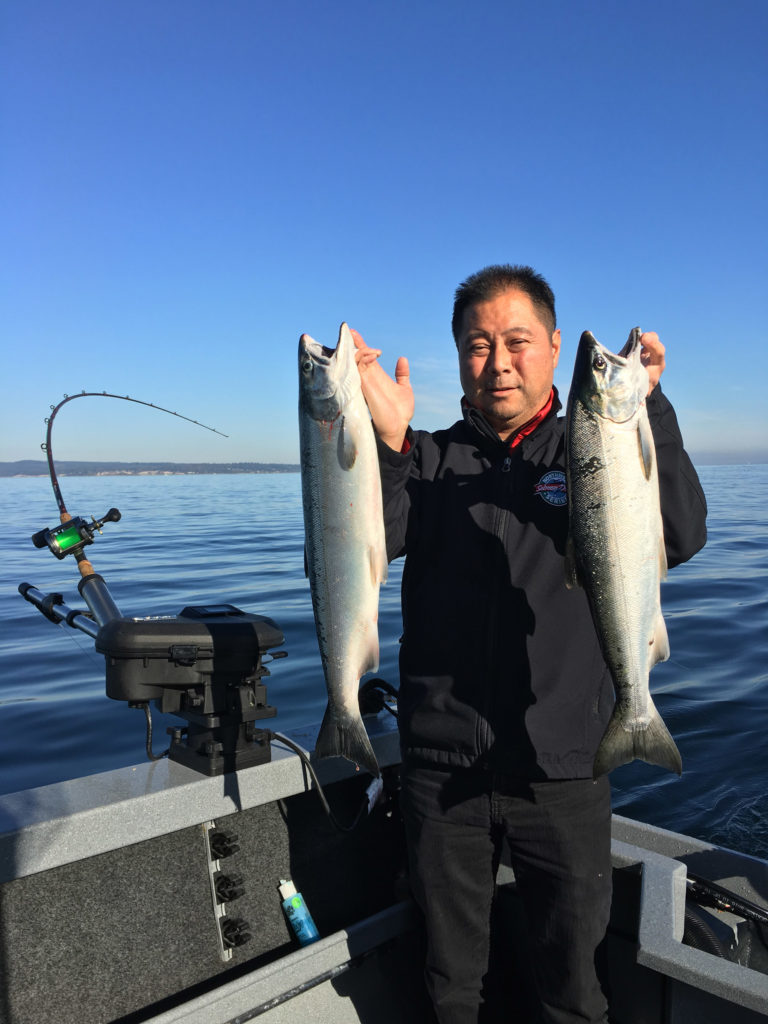
Summer is winding down, but that doesn’t mean you need to throw in the towel on salmon fishing options in September. Right now, coho salmon—known to anglers as “silvers” for their shiny silvery flanks—are starting to stage in the Strait of Juan de Fuca and some have even started to poke their noses into Puget Sound.
Coho aren’t large in stature and average 4 to 13 pounds, with some weighing 20-plus pounds. But despite not being the biggest in the salmon kingdom, when hooked they’re known to erratically zip around in all directions and will leap out of the water as they try to escape from being hooked.
For the fourth year in a row, Puget Sound coho returns are expected to exceed the half-million mark. If the coho returns wax expectations like several other salmon returns across Washington have done in 2022, anglers could see a dandy number of fish to catch. Fingers crossed! What we do know at this point is that the Puget Sound-wide hatchery coho forecast shows an 8% improvement and wild coho are up 9% compared to 2021 forecast. The recent 10-year average for hatchery coho is up 61% and the wild coho is up 29%. The combined 2022 Puget Sound hatchery and wild coho forecast is 666,468 compared to 614,948 in 2021; 504,604 in 2020; 708,521 in 2019; and 557,149 in 2018.
Earlier this summer, the resident coho fishing in central Puget Sound (Marine Catch Area 10) from mid-June into early-August was fair to good at times. These “stay at home” coho will also contribute to the early fall Puget Sound fisheries. The pilot run of coho should be generating action soon in the Strait of Juan de Fuca at Sekiu (Marine Area 5) and Port Angeles (Marine Area 6). Both areas are open daily through September 28 for hatchery-marked coho with a two-fish daily limit and the best areas to catch coho are usually in the Strait’s shipping channel. Keep tabs on schools of coho finning and jumping on the surface and baitfish schools on your fish finder. There is also a special Dungeness Bay coho fishery from October 1-31.
A fishery that remained closed in 2021 and is often regarded as a good spot for coho is Marine Area 7 in the San Juan Islands, which is now open daily through September 30 with a daily limit of two hatchery coho. Anglers should check the WDFW website for any emergency changes to the season dates. The northeastern side of Whidbey Island (Marine Area 8-1) was also closed in 2021 but an improved return of coho, mainly to the Skagit River (101,651 are forecasted to return in 2022 compared to 80,451 in 2021), should produce some decent fishing. The southern portion along the east side of Whidbey Island (Marine Area 8-2) below the Mukilteo-Clinton boundary line is a popular location for coho and will be open daily through September 19 with a two-hatchery coho daily limit.
Garnering the biggest spotlight for coho are northern Puget Sound (Marine Area 9), open for hatchery coho only daily now through September 25; and central Puget Sound (Marine Area 10), open for all coho daily now through October 31. Places to look for coho are Midchannel Bank off Port Townsend; Bush and Lagoon points off the west side of Whidbey Island; Marrowstone Island; Point No Point south to Pilot Point; Browns Bay; Possession Bar; Edmonds Marina to Richmond Beach; Kingston to Jefferson Head; Meadow Point to West Point near Shilshole Bay; Point Monroe; and Alki Point in West Seattle south to Redondo Beach. South central Puget Sound (Area 11) is also open for all coho through October 31; and southern Puget Sound (Area 13) is open year-round for hatchery-marked coho.
On the south-central coast, head to Grays Harbor, which is known to be productive for large-sized coho with a good number of them weighing between 15- and 20-plus pounds. The Grays Harbor forecast calls for a whopping 198,719 coho in 2022 up from 76,518 in 2021. In Grays Harbor, salmon fishing is open daily through September 15 in the North Bay for hatchery coho only with a one-fish daily limit; and then from September 16 through October 31 it is open for all coho only in the East Bay with a two salmon daily limit. I’ll see you on the water very soon!